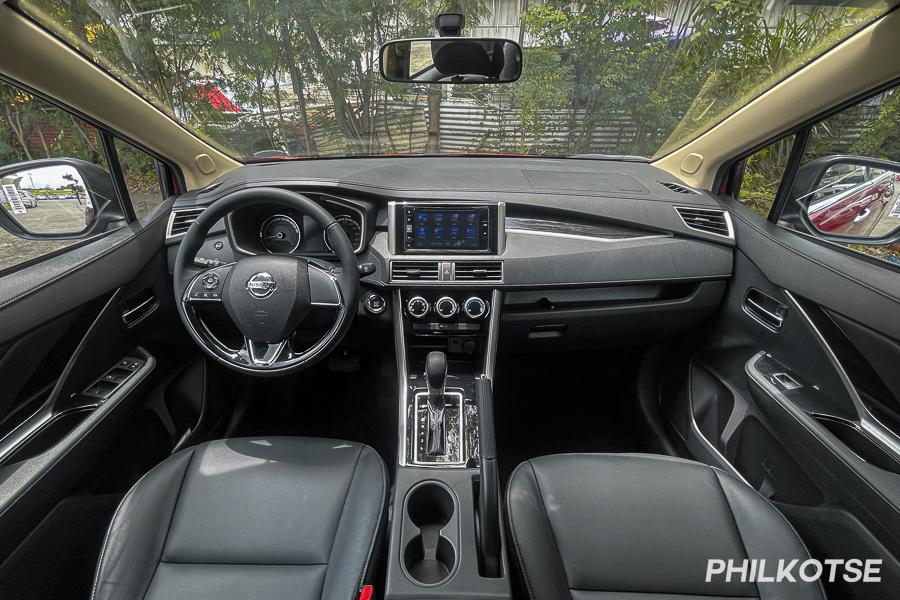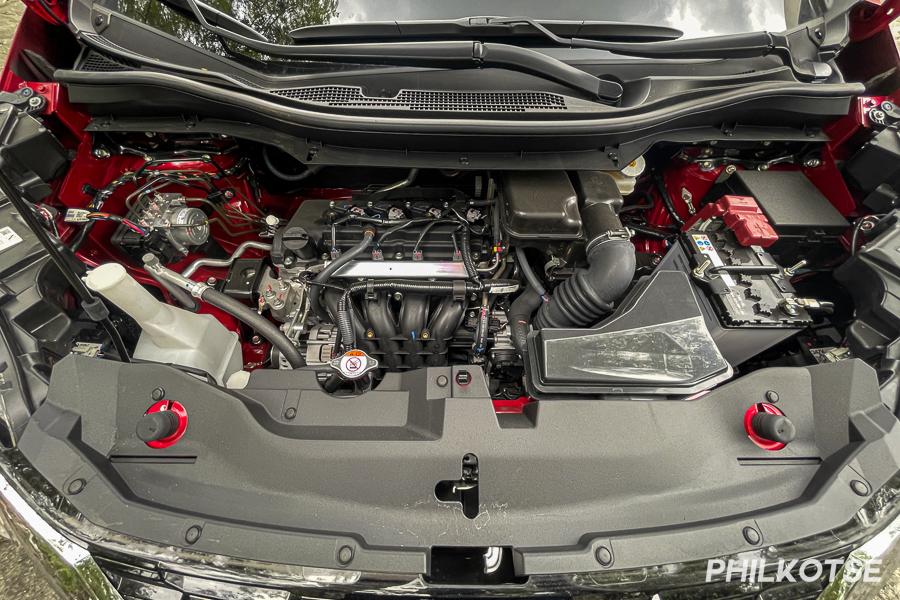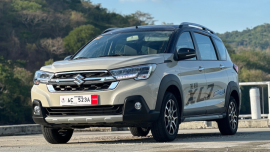
In this review...
- Joining the MPV fray
- Exterior
- Interior
- Tech & Safety
- Driving, Handling & Initial Fuel Economy
- Initial Verdict & Pricing
2023 Nissan Livina First Impressions Review: Joining the MPV fray
Competition in the automotive industry is important as it keeps the industry alive and kicking. In fact, the more population of competing cars and brands, the more options customers have. Case in point: the local MPV segment, which has the Toyota Avanza, Suzuki Ertiga, and Mitsubishi Xpander. Hyundai announced that it’s bringing in its contender this year, the Stargazer.

The all-new 2023 Nissan Livina
But before that happens, Nissan made the first move and introduced the Livina 2023 to Filipino car buyers. Born from the Renault-Nissan-Mitsubishi Alliance, the Livina is based on the Xpander and that should explain the unmistakable similarities between the two.
But why would you choose the Livina over the Xpander? There may be compelling reasons, which may not be valid for everyone. The new Livina is a great vehicle, just as the Xpander was great when it was introduced in the market four years ago – and that isn’t exactly a good thing.
2023 Nissan Livina First Impressions Review: Exterior
If you’re familiar with the Xpander, then the Livina should not be a stranger to you. The new Nissan MPV shares the same shell as the Mitsubishi, albeit with minor deviations apart from the badges.

A view of the Livina's front end
Up front, Nissan whips out its distinct V-Motion grille on the Livina. The MPV retains the split light configuration, with the upper part reserved for the LED daytime running lights, while the mid and bottom portions house the multi-reflector halogen headlights and fog lamps, respectively. Only the top-spec VL variant comes with silver accents, including the chrome side mirror covers.
When viewed from the side, the Livina appears almost exactly like an Xpander, save for the 16-inch alloys and the character lines on the front doors. The rear end is where the Livina appears to be a bit of an oddball. It retains the vertical taillight housing, but Nissan changed the LED graphic to match what you’ll see in the Almera subcompact sedan.

The Livina from the rear
For what it’s worth, Nissan has made the Livina its own – at least in the front and rear end. I like the styling, though I wish Nissan opted for LEDs especially considering the price point.
2023 Nissan Livina First Impressions Review: Interior
If you think that the Livina resembles the Xpander too much on the outside, wait until you’re in the presence of the interior. The dashboard layout, the instrument cluster display, the arrangement of the seven seats, the bevy of plastics used, even the air-conditioning controls and the odd placement of the parking brake lever – all of these things were lifted from the Xpander when it first arrived on our shores.

A peek inside the Livina with the third row folded down
Of course, there are some differences such as the badges, the faux-wood trims on the dashboard, and the touchscreen head unit differ a bit. This isn’t entirely a bad thing as the practicality, ergonomics, and durability of the Xpander made the Mitsubishi model popular among those shopping around for a seven-seater MPV.
That said, you’ll never run out of storage spaces and cubbyholes inside the Livina, though the second row can still use a pair of cupholders on the foldable center armrest – something that’s present in the facelifted Xpander launched this year.
2023 Nissan Livina First Impressions Review: Tech & Safety
With the adopted Xpander comes the tech and safety features… also from 2018. The Livina’s head unit lacks Apple CarPlay and Android Auto, but at least it has Bluetooth and a smartphone mirroring function that never worked during my tests. Also, the head unit surprisingly still has a CD player (time to blow the dust off on your favorite CD collection).

The Nissan Livina's cockpit
No automatic headlights here, the wipers are up to intermittent setting only, only dual front airbags are equipped, and there are no rear defoggers on the HVAC – it felt like the Livina is a bit dated especially when compared to the segment stalwarts. Even for the top-spec VL, cruise control isn’t standard, which will be a bit of a downer for those looking for this feature at this price point (such as myself).

A closer look at the Livina's dashboard and center console
But at least the Livina VL and VE come with rear parking sensors right off the showroom, along with vehicle dynamic control, traction control, and a reverse camera. The latter doesn’t have the best display on the planet, though.
2023 Nissan Livina First Impressions Review: Driving, Handling & Initial Fuel Economy
Also shared from the Xpander is the Livina’s sole power plant option, which is the normally aspirated 1.5-liter DOHC gasoline engine, capable of making 104 brake hp and 141Nm of torque. This is connected to a 4-speed AT (with OD switch), sending power to the front wheels.

The Livina's 1.5-liter inline-4 gasoline engine
Apart from the powertrain, the Livina uses the same oily bits as the Xpander, such as the McPherson strut with coil spring suspension up front and the torsion beam at the rear. Braking power’s the same as well – discs on the front wheels, drums on the rear.
That said, the Livina’s on-road behavior was pretty much what you would experience in the Xpander. Finding the appropriate driving position was a cinch, thanks to the tilt and telescopic adjustment of the tiller. The wide driving visibility made the small MPV easy to place within Metro Manila’s claustrophobic lanes, while power was enough to move seven occupants with ease. The acceleration needed a bit of refinement, but I wasn’t actually expecting much from the aging torque converter slushbox.

The Livina's gauge cluster
On the bright side, the Livina’s stable on the highway despite the steering feeling a bit vague at mid- and low-range speeds. It was also able to absorb road imperfections within reason with minimal jarring.
Under 100 kilometers of driving to and from the office (and for the shoot), I got 11.7 km/l. Take note that I live in the infamous Bicutan area in Parañaque and my office is located in Ortigas, so I covered all the bases – bumper-to-bumper traffic, fast speeds on Skyway, and an inevitable plight on the world-famous EDSA.
2023 Nissan Livina First Impressions Review: Initial Verdict & Pricing
The 2023 Nissan Livina starts at P1,029,000 for the base E MT variant. The EL AT is priced at P1,109,000, while the VE AT has a sticker price of P1,149,000. The top-spec VL AT that I’ve tested here can be had for P1,209,000.
Bringing the Livina here to compete against the very popular Mitsubishi Xpander might sound like Nissan going Livina Vida Loca. It might even sound crazier that Nissan has priced its contender relatively higher – at least with the top-spec VL (versus the Xpander GLS), while being less equipped.

Setting it apart from its Xpander sibling is it's V-Motion grille
But from a business standpoint, it kind of makes sense. It’s a way for Nissan to cover its bases in the hopes of selling more in the market. Simply put, if you’re wondering why Toyota’s number one in the Philippines, that’s because there’s essentially a Toyota for every kind of vehicle buyer – that, plus the esteemed reputation it has built over the years, but I digress.
However, there will always be a Livina buyer despite its disadvantages and shortcomings. May it be for the distinct V-Motion grille or because of the Nissan badge, that’s entirely up to the market. Whether you go for the Xpander or the Livina, it’s a win-win for the Renault-Nissan-Mitsubishi Alliance in which both brands fall. Business within dealerships is a different story, though.
Recommended articles
- nissan livina philippine debut september Aug 31, 2022
- Nissan Livina walkaround video Aug 11, 2022
- Nissan Livina spotted Aug 01, 2022












![Which 2023 Nissan Livina variant should you buy? [Comparison Guide]](https://img.philkotse.com/crop/94x52/2022/09/09/WFFKkBCT/090922-variantguide-nissan-livina-a90e_wm.jpg)
![Choose: Nissan Livina or Mitsubishi Xpander? [Poll of the Week]](https://img.philkotse.com/crop/94x52/2022/09/13/O3IWXvly/design-ae13_wm.png)







